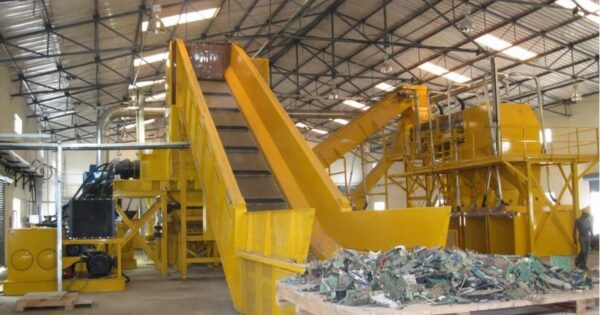How much lithium battery waste is produced every year in India and what is the potential for lithium and other critical material recovery?
In India, approximately 70,000 metric tons of lithium battery waste is generated annually, posing several environmental challenges. With proper recycling infrastructure and technology, a significant portion of these batteries could be recycled, reducing the demand for virgin raw materials that will in turn lead to a reduced environmental impact.
Battery recycling typically begins with the collection of end-of-life lithium-ion batteries (LiB) used in electric vehicles (EVs). Subsequently, the batteries undergo pre-processing and disassembly, leading to the discharge of LiBs. The subsequent phase involves the generation of ‘Black Mass’ via mechanical or thermal process, after which it is forwarded to suitable recycling companies.
Black mass denotes the material obtained, rich in lithium, manganese, cobalt, and nickel content. These components can be reintegrated into battery production or repurposed for alternative applications.
Attero is the only company in India and among the leading global companies conducting end-to-end processing and refining of black mass, extracting pure battery-grade cobalt, lithium carbonate, graphite, nickel, and more with an extraction rate of over 98%. This exceptional performance far surpasses global competitors, who typically achieve recovery efficiencies of less than 75%.
Through its formal recycling processes, Attero demonstrates how recyclers can sustainably extract valuable materials such as lithium, cobalt, and nickel for reuse in new battery production.
Which recycling technologies are promising and why?
Li-ion battery recycling is mainly done following two primary processes: Pyrometallurgy and Hydrometallurgy. Hydrometallurgy utilizes a process known as mechanical pre-treatment to extract black mass. Subsequently, leaching occurs, employing reagents and solvents. Following this, mineral recovery is achieved through chemical or electro-extraction, with recovery rates reaching as high as 95%.
In contrast, Pyrometallurgy involves heating ores at high temperatures to extract minerals. While approximately 50-60% of minerals like nickel and cadmium are extracted, this method leaves behind lithium and aluminum, resulting in a lower recovery rate for these elements.
That said, Hydrometallurgy holds promise for sustainable resource recovery from battery grids, contributing to both environmental conservation and the circular economy. Further advancements and research are crucial for enhancing efficiency and expanding the scope of materials recovered.
Attero utilizes a comprehensive mechanical and hydrometallurgy process to recover the majority of metals with a recovery efficiency rate of more than 98%, while prioritizing sustainability. Attero’s NASA-approved technology, backed by 45+ granted global patents and with numerous applied for, delivers remarkable efficiency with a high extraction rate.

Attero
How energy and cost-intensive is lithium battery recycling? How can it be made environment friendly?
Lithium-ion battery recycling, when supported by efficient technology, need not be inherently energy-intensive. While traditional methods may involve complex separation processes and specialized equipment, advancements in sorting techniques and automation have opened avenues for energy savings.
Innovative approaches such as hydrometallurgical processes bypass energy-intensive melting procedures, thus reducing both energy requirements and costs. At Attero, the lithium recycling process exemplifies this shift, boasting 99% fewer greenhouse gas emissions than the extraction of virgin metals. Internal studies further indicate substantial savings in terms of GHG emission for extracted critical materials as compared to the baseline emissions; 63% less emissions in case of graphite, cobalt (57%), copper (67%), and lithium carbonate (98%). [Baseline emission refers to the initial level of emissions generated by a particular process.]
Transitioning recycling facilities to renewable energy sources further minimizes environmental impact. By implementing robust collection systems and incentivizing consumer participation, a circular economy mindset can be fostered, optimizing resource use.
What are your future plans?
We plan to expand Attero’s global footprint by processing 300,000 metric tons per annum over the next four years. Out of which, one lakh would be for the Indian market and one lakh each would be for the US and Europe. Additionally, we plan continuous optimization of the recycling of critical materials like graphite, cobalt, and copper, with significant savings ranging from 43% to 99%.
This content is protected by copyright and may not be reused. If you want to cooperate with us and would like to reuse some of our content, please contact: editors@pv-magazine.com.









By submitting this form you agree to pv magazine using your data for the purposes of publishing your comment.
Your personal data will only be disclosed or otherwise transmitted to third parties for the purposes of spam filtering or if this is necessary for technical maintenance of the website. Any other transfer to third parties will not take place unless this is justified on the basis of applicable data protection regulations or if pv magazine is legally obliged to do so.
You may revoke this consent at any time with effect for the future, in which case your personal data will be deleted immediately. Otherwise, your data will be deleted if pv magazine has processed your request or the purpose of data storage is fulfilled.
Further information on data privacy can be found in our Data Protection Policy.